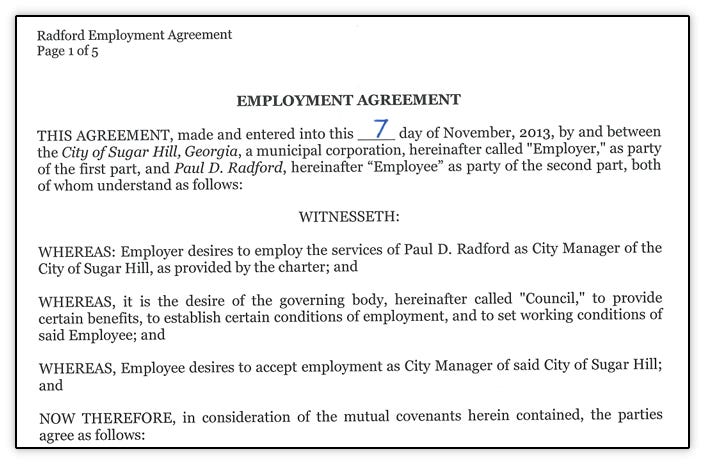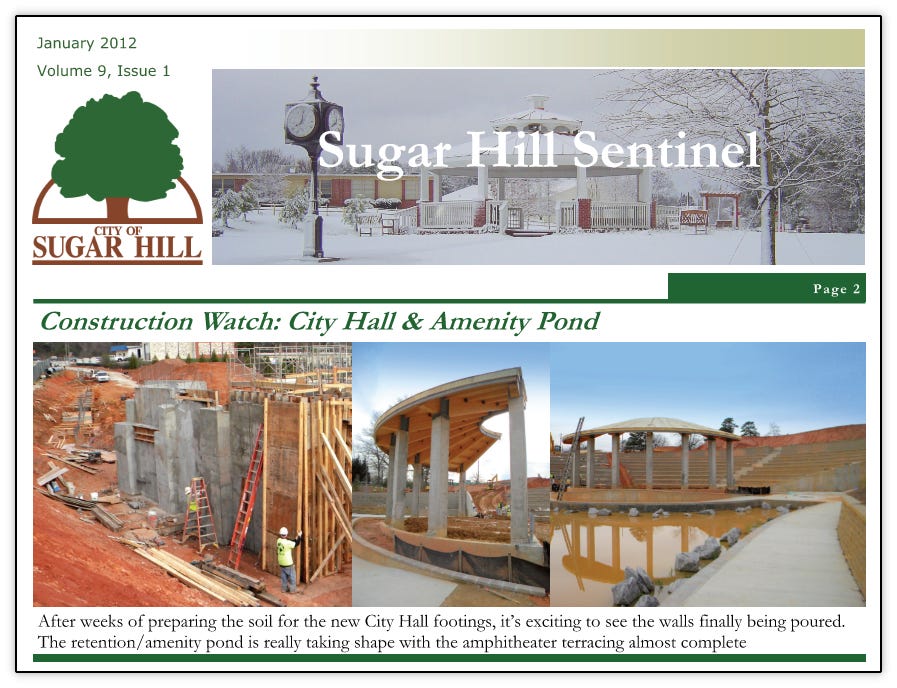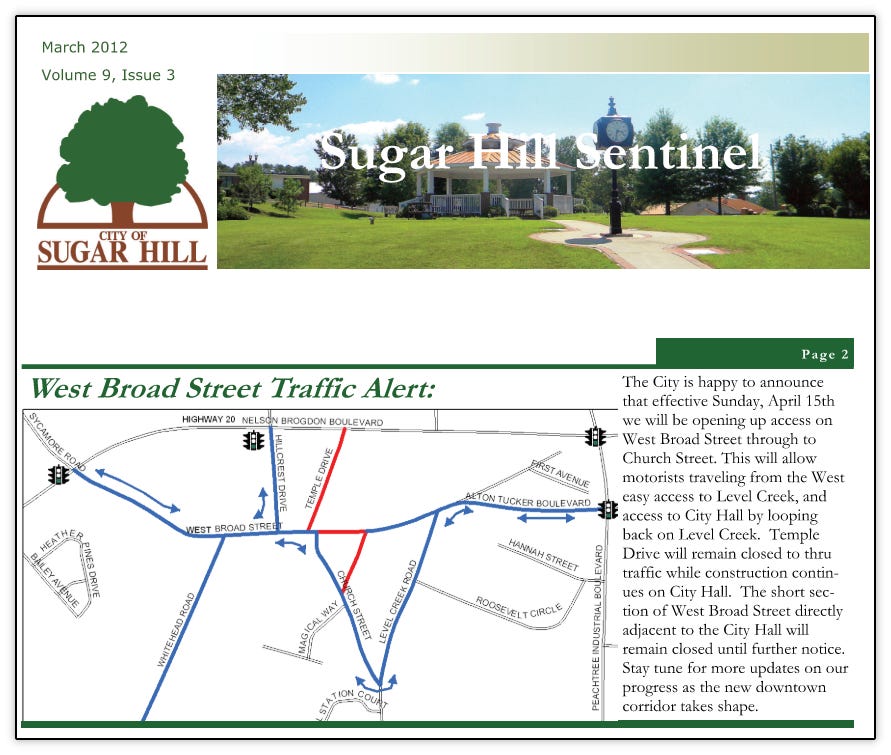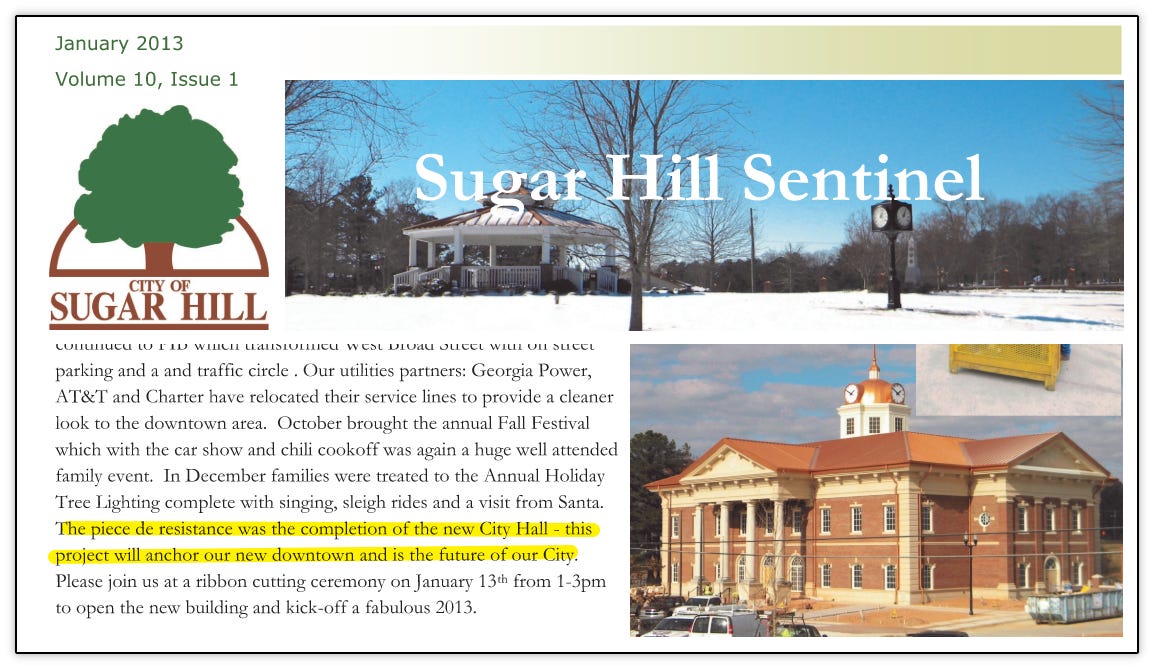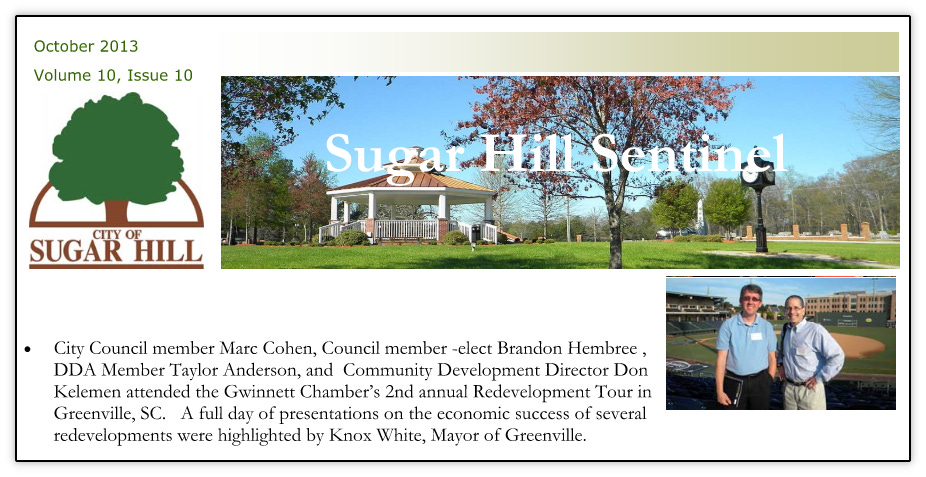Opening the New City Hall and a Changing of the Guard
2012 and 2013 would bring a new city hall to downtown as a new mayor and city manager take the leadership reins.
In this article, we return to the historical context of how we got to where we are today. As a refresher, here are the articles so far in timeline order starting in 1998:
The 1998 Comprehensive Plan including the 2002 readoption
That brings us to a transformative period for the city in 2012 and 2013. As the foundation for the future of the city had been set, new leadership would emerge in these two years along with downtown’s keystone building, the new City Hall.
While there were no substantial policy or planning activities during the period, it would be a time of execution, construction and leadership change.
In this article, we’ll cover:
New leadership;
New City Hall and West Broad Street;
The Downtown Development Authority (DDA) gets active;
Groundbreaking on the widening of Highway 20; and
The Lanier Cluster schools becoming part of the city.
New Leadership
2012 and 2013 saw the addition and/or changing of roles of a number of new leaders in the city.
In January 2012, current Mayor Brandon Hembree, who recently won re-election for a second term, would join the Downtown Development Authority (DDA), his first role with the city. I would join him at the same time on the DDA. I had read the vision from the 2005 Town Center Master Plan and was excited to be a part of the team bringing that to reality.
I had been invited to get involved in the city by then City Council Member Marc Cohen.

After submitting my resume and having an interview with then City Manager Bob Hail, I was offered the opportunity to serve on the City’s DDA by Mayor and Council, which I accepted and was sworn in at the February 2012 City Council Meeting.
Paul Radford was hired by Mayor and Council as Assistant City Manager in 2013 and would assume the role of City Manager in mid-2014 with the retirement of long time City Manager Bob Hail. The City’s Charter allows for the City Council to hire the City Manager, City Clerk, City Attorney, City Accountant and Tax Collector. All other employees are hired by and report directly to the City Manager.

Also in 2013, Mayor Gary Pirkle announced he would not run again after 12 years as Mayor. He endorsed then City Council Member Steve Edwards for Mayor. Steve Edwards was the lone qualifier for Mayor and would assume the role in January 2014.
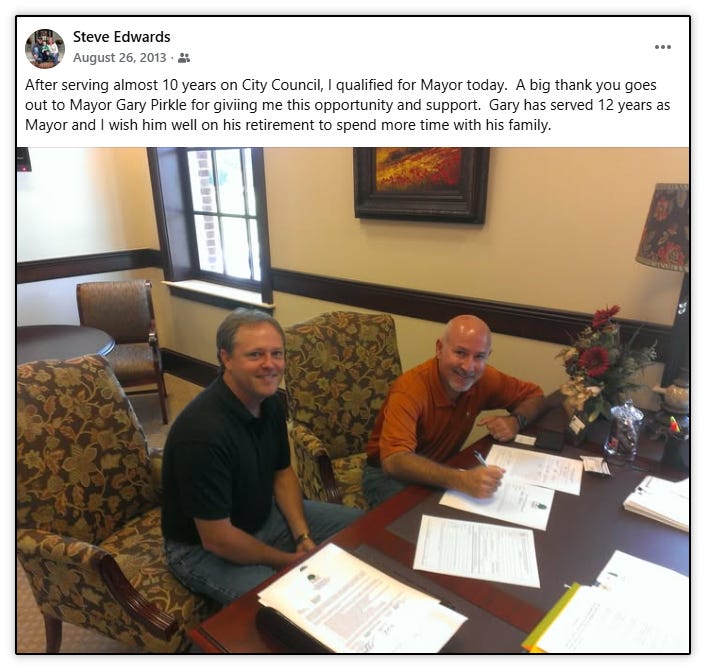
The new leadership under Mayor Steve Edwards and City Council was to make downtown a priority. The city had already acquired a number of downtown properties under Mayor Gary Pirkle and City Manager Bob Hail. The directive was to move forward on the city’s master plan for downtown now that the Great Recession had subsided and the economy was back on track.
In September 2013, a special called election was held to fill the vacant seat of Steve Edwards. DDA member Brandon Hembree was the lone qualifier for the special election and assumed office in October 2013 after being sworn in by Mayor Gary Pirkle.

In summary, here are the key leadership changes that occurred over those two years:
Steve Edwards: Mayor
Paul Radford: City Manager
Brandon Hembree: DDA and City Council
Taylor Anderson: DDA
Marc Orcutt: DDA
New City Hall and West Broad Street
As was outlined in this previous article, the city broke ground on the new City Hall and West Broad Street in October 2010 that were to become the cornerstone and bedrock of the new downtown. Construction continued all through 2011 and 2012. Below are various updates from the city’s newsletter at the time, Sugar Hill Sentinel documenting the progress.

The “new downtown corridor” was taking shape, causing closures and re-routing of traffic during the construction.
The city heralded the completion of City Hall, calling it “the anchor of our new downtown and is the future of our City.”
City Hall’s Grand Opening on Sunday, January 13th with local, state and federal officials in attendance.

The opening of City Hall set the direction for the city and future of downtown.
Downtown Development Authority Gets Active
The City’s DDA had been in existence for several years but really had not made progress until the city began work on City Hall and West Broad Street along with the other infrastructure improvements necessary to see downtown thrive. Now that headway on those projects was being made, the DDA was ready to move forward on the city’s plans for downtown.
We would get to work immediately on promoting downtown and the redevelopment opportunities at the direction of Mayor and Council. DDA Chairman Dawn P. Gober would become a constant source of inspiration and cheerleading for the city with the newly energized DDA. This included a significant presence at a number of events, like the Gwinnett Chamber’s recently begun Redevelopment Forum which would eventually become the Metro-Atlanta Redevelopment Summit.
As part of fulfilling Mayor and Council’s directive to promote and building of downtown, the DDA would engage the public and specifically downtown businesses. On April 30th, the DDA hosted an evening downtown to discuss plans for the future of downtown.
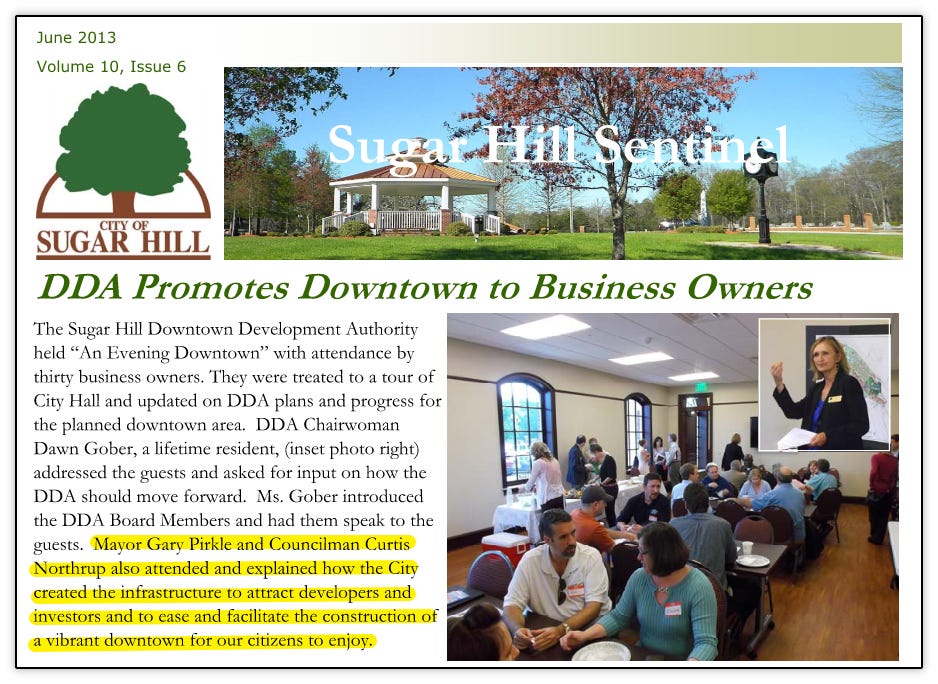

New events were being tested in the yet to be named amphitheater. These early events would lead to the growth of concerts, theatrical plays and many other community events in what will become “The Bowl @ Sugar Hill”.
The city’s push for downtown included attendance at the Gwinnett Chamber’s Redevelopment Tour in Greenville, South Carolina in October 2013. Greenville would become a constant source of inspiration for downtown Sugar Hill, with it’s Main Street between the Reedy River and the Hyatt, and Sugar Hill’s main street, West Broad Street between PIB and Hwy, covering the same 3/4 mile distance.
In November 2013, Marc Orcutt became a member the DDA. Marc would go on to become Chairman of the DDA in 2018 and become instrumental in the lease out of The Suite Spot and the E Center when those projects come to life along with several other projects in downtown. At the time, he was owner of Xenier Media located in downtown.
The DDA led by Chairman Dawn P. Gober would see significant progress in 2012 and 2013 towards the realization of city’s plan for downtown with support from Mayor and Council and the opening of new City Hall and transformed West Broad Street.
Highway 20 Widening Breaks Ground
Another major milestone in the city’s history was groundbreaking on the major east/west highway in the city - Highway 20. The widening of Highway 20 by Georgia and Gwinnett Department of Transportation would bring major attention and a lot more traffic to the city. While this would just be the groundbreaking and the project would be completed for several more years, it was a major change in the city that would have far reaching impacts.
Lanier Cluster Becomes Part of the City
In December 2013, the Lanier Clusters became part of the city through a legislative annexation, solidifying their status as part of the city. The school cluster opened in 2008. However, incorporating the property they sit on within the city limits solidified their importance to our community, forming the foundation of their relationship with the city today.
Conclusion
2012 and 2013 were major transitional years for the city in both leadership and downtown construction. The handoff featured the foundation being completed from both a planning perspective and building/infrastructure perspective.
The future years would see major progress in both planning and construction efforts building on the Strong Community that Sugar Hill had building towards in the prior decade.




